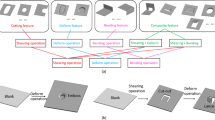Abstract
The process of designing progressive dies can be complex, tedious, time-consuming, and error-prone, which can significantly impact the development period and design quality. This paper presents a systematic methodology that includes the planning design and automated design of die structure. A super process model (SPM) is presented as the output of the planning design of die structure and the input of the automated design of die structure. Subsequently, parametric template methodology based on deformation feature process geometry (DFPG) is proposed to automate the design of punches and dies. Lastly, a layout method based on layout space for standard parts is proposed to perform the automated layout of standard parts for die-sets, punches, and dies; additionally, a robust calculation method of layout space is introduced. This system is then implemented in two home appliance enterprises. Case studies and industrial applications have demonstrated the effectiveness of the developed system, which can improve the design efficiency by a minimum of 85% and reduce design error by an average of 50%.

























Similar content being viewed by others
References
Cakir M, Irfan O, Cavdar K (2005) An expert system approach for die and mold making operations. Robot Comput-Integr Manuf 21:175–183
Kumar S, Singh R (2007) A knowledge-based system for selection of progressive die components. J Achiev Mater Manuf Eng 20:475–479
Kumar S, Singh R (2007) An intelligent system for automatic modeling of progressive die. J Mater Process Technol 194:176–183
Kumar S, Singh R (2011) An automated design system for progressive die. Exp Syst Appl 38:4482–4489
Potocnik D, Dolsak B, Ulbin M (2013) An automated design system for compound washer dies. J Braz Soc Mech Sci Eng 35:293–304
Lin B-T, Huang K-M, Su K-Y, Hsu C-Y (2013) Development of an automated structural design system for progressive dies. Int J Adv Manuf Technol 68:1887–1899
Naranje V, Kumar S (2014) A knowledge based system for automated design of deep drawing die for axisymmetric parts. Exp Syst Appl 41:1419–1431
Zhou S, Zhao X, Li J (2008) Application of UDF in blanking punch structure design based on UG. Die Mould Industry 34:22–25
Jia Z, Li H, Zhang X, Li J, Chen B (2011) Computer-aided structural design of punches and dies for progressive die based on functional component. Int J Adv Manuf Technol 54:837–852
Fan Q, Liu G, Wang W (2011) Development of Die Sets standard parts library based on Pro/E. Procedia Eng 15:3802–3807
Sun B, Qin G, Fang Y (2011) Research of standard parts library construction for SolidWorks by Visual Basic. Proc Int Confer Electr Mech Eng Inform Technol 5:2651–2654
Mok H-S, Kim C-H, Kim C-B (2011) Automation of mold designs with the reuse of standard parts. Exp Syst Appl 38:12537–12547
Wei Y, Wang Z, Zhang Z, Liu Y, Yuan X (2018) Methodology of automated and robust and rapid layout of standard part for multi-plate die based on distributed assembly modeling strategy. Int J Adv Manuf Technol 94:1197–1207
Gupta RK, Gurumoorthy B (2013) Classification, representation, and automatic extraction of deformation features in sheet metal parts. Comput Aided Des 45:1469–1484
Yang Y, Hinduja S, Owodunni O, Heinemann R (2021) Recognition of features in sheet metal parts manufactured using progressive dies. Comput Aided Des 134:102991
Lin B-T, Hsu S-H (2008) Automated design system for drawing dies. Expert Syst Appl 34:1586–1598
Hao Y, Wang Y (2017) A knowledge-based parametric design system for trimming dies. DEStech Trans Comput Sci Eng. https://doi.org/10.12783/dtcse/icmsie2016/6315
Wang Y, Hu X (2011) Research on template-based parameterized structure design for drawing dies. In: Proceedings of the 2011 2nd International Conference on Digital Manufacturing and Automation. IEEE, Zhangjiajie, China, pp 1022‒1025
Vatti BR (1992) A generic solution to polygon clipping. Commun Assoc Comput Machinery 35:56–63
Chen X, McMains S (2008) Polygon offsetting by computing winding numbers. In: Proceedings of the ASME 2005 International Design Engineering Technical Conferences and Computers and Information in Engineering Conference, vol 2. ASME, Long Beach, CA, pp 565–575
Li B, Zhu W, Eynard B, Bricogne M (2014) Researched on the technology of machining simulation. Adv Mater Res 1039:390–396
Funding
This work was supported by Foshan Institute of Intelligent Equipment Technology (Grant number 2021B0101220001).
Author information
Authors and Affiliations
Contributions
Haijiao Kong was responsible for conceptualization, investigation, methodology, software, and writing of an original draft. Zhibing zhang contributed to the layout of standard parts. Review and editing of the manuscript were provided by Yang Wei and Yuqi Liu.
Corresponding author
Ethics declarations
Consent to participate
The authors consent to participate.
Consent for publication
The authors consent to publish.
Competing interests
The authors declare no competing interests.
Additional information
Publisher's note
Springer Nature remains neutral with regard to jurisdictional claims in published maps and institutional affiliations.
Rights and permissions
Springer Nature or its licensor (e.g. a society or other partner) holds exclusive rights to this article under a publishing agreement with the author(s) or other rightsholder(s); author self-archiving of the accepted manuscript version of this article is solely governed by the terms of such publishing agreement and applicable law.
About this article
Cite this article
Kong, H., Zhang, Z., Wei, Y. et al. Development of an automated structural design system for progressive dies based on the integrated design methodology of process and structure. Int J Adv Manuf Technol 126, 4239–4258 (2023). https://doi.org/10.1007/s00170-023-11346-9
Received:
Accepted:
Published:
Issue Date:
DOI: https://doi.org/10.1007/s00170-023-11346-9




